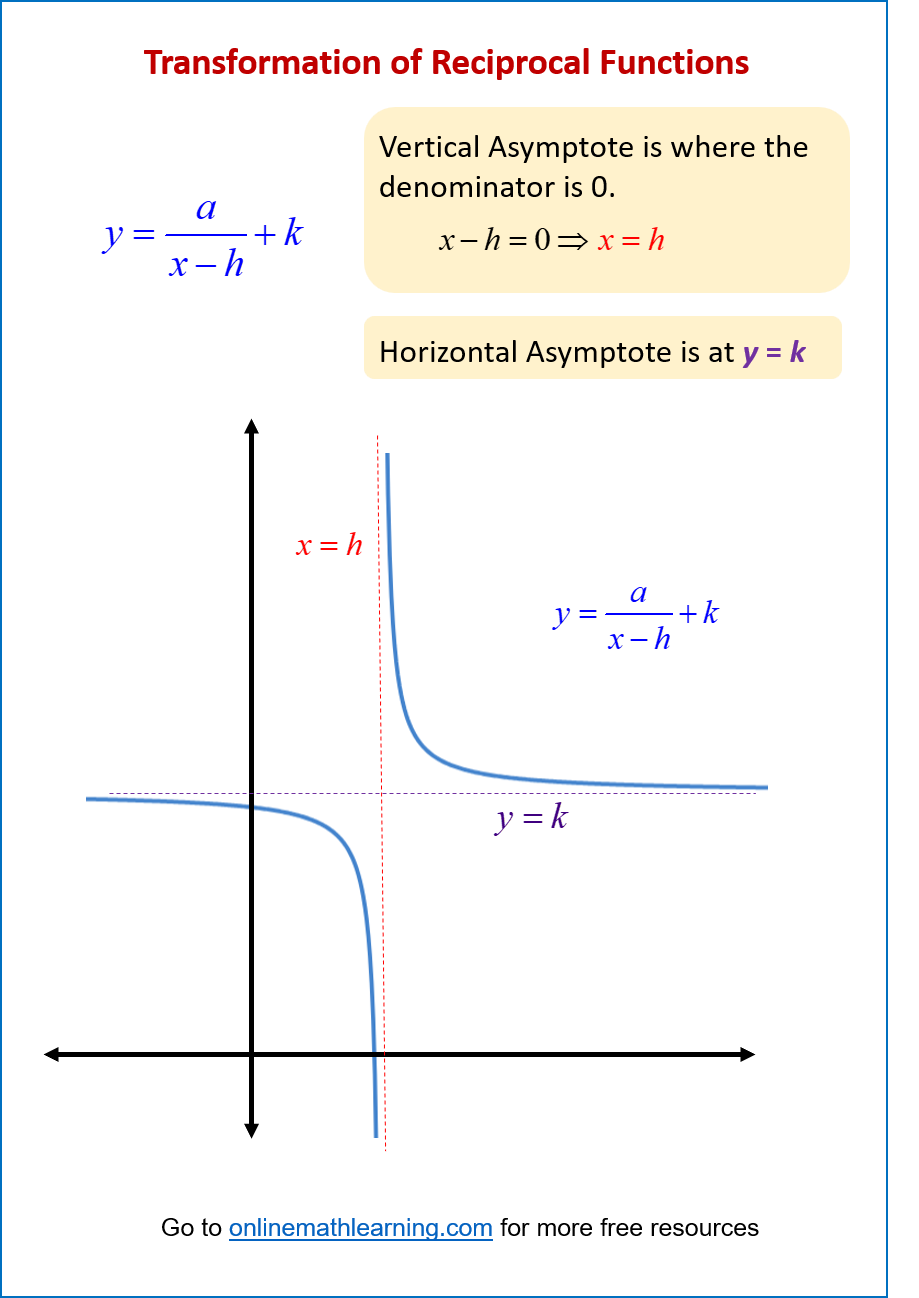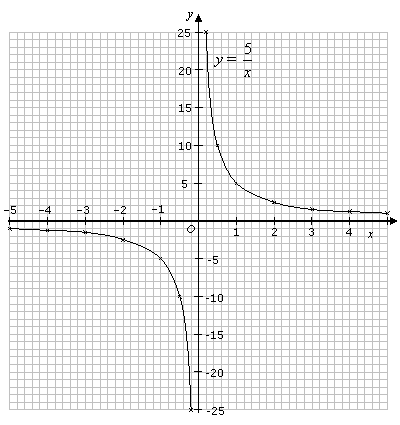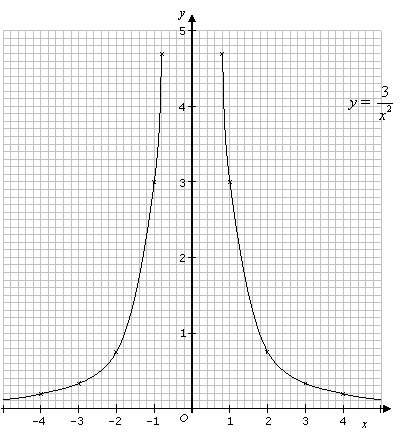Graphs Of Reciprocal Functions
Related Pages
Reciprocal Of A Function
Graphs Of Functions
In these lessons, we will learn:
- how to graph reciprocal functions by plotting points.
- the characteristics of graphs of reciprocal functions.
- how to use transformations to graph a reciprocal function.
- how to graph a reciprocal function when given its equation.
- how to get the equation of a reciprocal function when given its graph.
The transformation of a reciprocal function involves altering its basic shape and position on a graph. The standard form of a transformed reciprocal function is:
\( f(x) = \frac{x}{x-h} + k\)
where:
\(a\) affects the vertical stretch or compression and reflection.
\(h\) causes a horizontal shift.
\(k\) causes a vertical shift.
The following diagram shows How to use transformation to graph reciprocal functions? Scroll down the page for more examples and solutions on graphing reciprocal functions.

How To Graph Reciprocal Functions?
There are several forms of reciprocal functions. One of them has the form y =
![]() ,
where k is a real number and x ≠ 0.
,
where k is a real number and x ≠ 0.
What Are The Characteristics Of The Graph Of A Reciprocal Function?
The graph of y = ![]() gets closer to the x-axis as the value of x increases, but it never meets the x-axis. This is
called the horizontal asymptote of the graph.
gets closer to the x-axis as the value of x increases, but it never meets the x-axis. This is
called the horizontal asymptote of the graph.
Each piece of the graph also gets closer to the y-axis as x gets closer to 0 but it never meets the y-axis because there is no value for y when x = 0. This is called the vertical asymptote of the graph.
This type of curve is called a rectangular hyperbola.
Note that this type of curve, the graphs of y =
![]() where k is a real number and x ≠ 0, has two lines of symmetry: y = x and y = x.
where k is a real number and x ≠ 0, has two lines of symmetry: y = x and y = x.

How To Graph Reciprocal Functions By Plotting Points?
Example:
Draw the graph of y = ![]() for values between 4 and 4, except for x = 0.
for values between 4 and 4, except for x = 0.
Solution:
| x | 0.2 | 0.5 | 1 | 2 | 3 | 4 | 5 |
|---|---|---|---|---|---|---|---|
| y | 25 | 10 | 5 | 2.5 | |
1.25 | 1 |
| x | 0.2 | 0.5 | 1 | 2 | 3 | 4 | 5 |
|---|---|---|---|---|---|---|---|
| y | 25 | 10 | 5 | 2.5 | |
1.25 | 1 |
The curve consists of two separate pieces, but they should be regarded as one graph.

How To Use Transformation To Graph Reciprocal Functions?
Introduction to reciprocal functions, identifying asymptotes and graphs of reciprocal functions, stretching, shrinking, and translating reciprocal functions, and graphing reciprocal functions.
y = 1/x and y = a/(x − h) + k.
Stretch when a > 1 and shrink when 0 < a < 1.
Graphs for positive and negative a values.
h translates horizontally and k translates vertically.
Examples:
- Compare the graphs y = 1/x, y = 5/x and y = 1/(5x)
- Compare the graphs y = 1/x and y = -1/x
- Compare the graphs y = 1/x, y = 1/(x - 4) and y = 1/x - 4
- Graph y = 2/(x - 4) + k
Describe The Characteristics Of The Reciprocal Function f(x) = 1/x
Explain the domain, range, vertical and horizontal asymptotes.
Transformation Of Reciprocal Functions
How to use transformation to graph reciprocal functions?
\(f(x) = \frac{a}{{x - h}} + k\)
h is the horizontal translation
if h is positive, shifts left
if h is negative, shifts right
h also shifts the vertical asymptote
k is the vertical translation
if k is positive, shifts up
if k is negative, shifts down
k also shifts the horizontal asymptote
a is orientation and shape
if a is negative, reflection across x-axis
if a > 1, stretched vertically
if 0 < a < 1, compressed vertically
Example:
Graph, then state the domain, range and asymptotes
- \(f(x) = \frac{2}{{x}} + 3\)
- \(f(x) = \frac{3}{{x - 2}}\)
- \(f(x) = \frac{4}{{x + 3}} - 5\)
- \(f(x) = \frac{4}{{x^2}} - 4\)
- \(f(x) = 6 - \frac{2}{{(x - 3)^2}}\)
How To Graph A Reciprocal Function With A Horizontal Translation?
Sketch the Reciprocal Function using Transformations
Example:
Graph y = 1/(x - 3).
Graphing Transformations Of Reciprocal Function
Example:
Given the function \(y = \frac{{ - 2}}{{3(x - 4)}} + 1\)
a) Determine the parent function
b) State the argument
c) Rearrange the argument if necessary to determine and the values of k and d
d) Rearrange the function equation if necessary to determine the values of a and c
e) State the transformations (in an appropriate order) that are performed on the graph of the
parent function to obtain the graph of the function given.
Method 1:
f) Graph each transformation in the appropriate order given in part e), and show the graph of
the given function in a distinctive colour.
Method 2:
g) Use the table method to determine coordinate of the function given, the graph.
Method 3:
h) Use the transformation formula to determine coordinates of the function given, then graph.
How To Graph Reciprocal Functions When Given The Equation?
How to graph functions that are 1/x and variations of that.
Find asymptotes, intercepts, and use a couple test values.
- To get the vertical asymptote, set denominator = 0
- To get the horizontal asymptote, imagine x getting really big
- To get the y-intercept, set x = 0
- To get the x-intercept, set y = 0
- Do test values on either side of the vertical asymptote
Example:
Graph m(x) = \(y = \frac{{ - 17}}{{18 - 8x}} - 4\).
How To Find The Equation Of A Reciprocal Function When Given Its Graph?
This video shows how to get the equation of a reciprocal function from its graph.
- Find the vertical asymptote. This is the root of the denominator.
- Find the horizontal asymptote. This is added/subtracted from your fraction.
- Find a point on the curve, and plug into the equation. Solve for numerator.
Another form of reciprocal functions is y =
![]() ,
where k is a real number and x ≠ 0.
,
where k is a real number and x ≠ 0.
Example:
Draw the graph of y =
![]() for 4 ≤ x ≤4 and x ≠ 0.
for 4 ≤ x ≤4 and x ≠ 0.
Solution:
| x | 4 | 3 | 2 | 1 | 0.8 | 0.8 | 1 | 2 | 3 | 4 |
|---|---|---|---|---|---|---|---|---|---|---|
| y | 0.19 | 0.33 | 0.75 | 3 | 4.69 | 4.69 | 3 | 0.75 | 0.33 | 0.19 |

Notice that graphs of y = ![]() ,
where k is a real number and x ≠ 0, has an axis of symmetry on the y-axis (i.e. x = 0)
,
where k is a real number and x ≠ 0, has an axis of symmetry on the y-axis (i.e. x = 0)
Try out our new and fun Fraction Concoction Game.
Add and subtract fractions to make exciting fraction concoctions following a recipe. There are four levels of difficulty: Easy, medium, hard and insane. Practice the basics of fraction addition and subtraction or challenge yourself with the insane level.

We welcome your feedback, comments and questions about this site or page. Please submit your feedback or enquiries via our Feedback page.